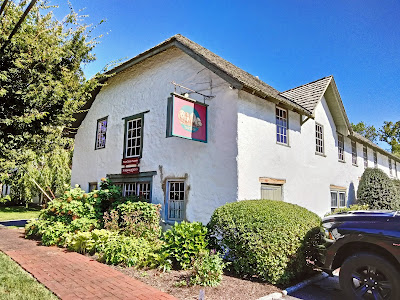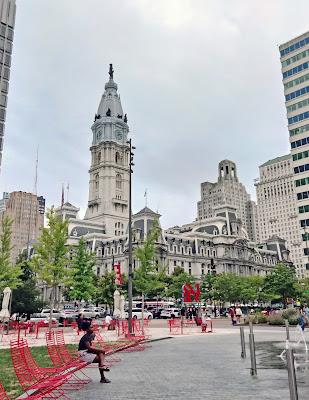Thursday, August 24, 2023
We headed early into Philadelphia, driving to Springfield Mall, catching the 101 trolley to the 69th Street Station, then taking the Market Franklin train to 15th Street. It was drizzling as we walked to the
Academy of Natural Sciences of Drexel University. We had borrowed a Delaware County Libraries Museum Pass for free admission to the museum.
This is actually our ninth trip relating to Lewis & Clark and the Corps of Discovery Expedition. (Click on the number to view the trip posts.)
1) Meriwether Lewis was appointed commander of an expedition to the Pacific, and began preparations for the expedtion by going to Harpers Ferry, VA (WV) and Lancaster, PA.
2) Meriwether Lewis continued preparations by learning from experts in various fields of study, in Philadelphia.
3) Meriwether Lewis traveled to Harpers Ferry to pack up supplies, continued to Pittsburgh, then began the expedition down the Ohio River to Steubenville, OH.
4) The main trip to follow the Corp of Discovery Expedition from Steubenville down the Ohio River, up the Mississippi River, then up the Missouri River, 1803-1804 winter encampment, over the Rocky Mountains, down the Snake and Columbia Rivers, 1804-1805 winter encampment, plus some of the return routes.
5) Birthplaces of William Clark and Meriwether Lewis, then following the collections brought back from the expedition, first at Monticello.
6) Natchez Trace Parkway Trip for the final resting place of Meriwether Lewis.
7) American Philosophical Society for the Lewis & Clark journals.
8) Charles Fritz:
100 Paintings Illustrating the Journals of Lewis & Clark.
 |
Meriwether Lewis returned to Philadelphia
in 1806 to leave many artifacts with
Charles Willson Peale who displayed
certain objects in his museum |
 |
We continue following up on the specimens brought back
by the Corps of Discovery Expedition, at the Academy of
Natural Sciences (founded 1812, building 1876) |
*On August 6, 1804, Sergeant Patrick Gass found a piece of a fossilized fish jawbone.* *The label in the handwriting of Meriwether Lewis described: "Petrifed Jaw bone of a fish or some other anamal found in a cavern a few miles distance from the Missouri S[tarboard] side of the River. 6 Aug. 1804." (Cavern is thought to mean an undercut in the bank of the river or creek.)* |
The fossil has been identified as from the maxilla/
upper jawbone of Saurocephalus lanciformis/a fish with a
spear-shaped lizard-head from the Late Cretaceous Epoch,
and was a new genus and species of fossil fish;
note the small teeth on the lower edge |
 |
Part of the Thomas Jefferson Fossil
Collection; Mastadon jawbones with teeth |
In 1807, the American Philosophical Society directed William Clark to obtain fossilized mastadon bones from Big Bone Lick in Kentucky.
 |
Also in the collection, one horn and part of
the skull of Bison latifrons/Giant Bison or
Long-horned Bison (now extinct) from
the Pleistocene Epoch |
 |
Knowing Jefferson's interest in fossils, an acquaintance
from Greenbrier County, VA (now WV) sent him
these fossilized bones of a forearm and claw of
what was believed to be a giant lion |
Because Thomas Jefferson was the first person to describe these bones in a scientific paper, he has been credited with the discovery by having the species named for him:
Megalonyx jeffersonii/ a type of Giant Ground Sloth (Middle to Late Pleistocene Epochs).
 |
| Exposed trilobites make an artistic tableau (KSS) |
 |
| An example of a rocks and minerals collection drawer |
 |
Specimens of Selenite/a clear, colorless variety of gypsum
that occurs in clays, are from the Adam Seybert Collection,
perhaps the oldest intact collection in the United States |
Of these selenites, three were definitively collected by Lewis & Clark: #3, #5, and #6; although it is presumed that all displayed here could be from the Corps of Discovery Expedition, probably collected from August 21, 1804 (Missouri River at the confluence of the Floyd River) through October 1804 (Fort Mandan).
 |
Also collected by Lewis & Clark: the rock on the left was
described by Lewis as "lava" and on the right as "pummice,"
yet both are clinkers/sedimentary rock that has been
metamorphosed by the heat of burning coal beds
in what became North Dakota |
 |
An amazing slice of a 6-billion year old meteorite
discovered in 1822 in Chile |
 |
| Some colorful Fluorites/the mineral form of calcium fluoride |
 |
The Botany lab where plant specimens are being
transferred to archival paper |
 |
A cabinet of botanical specimens,
specifically "type specimens"/the exact
specimen with details published in a
scientifically recognized publication
including a published scientific name and
the official description defining the
characteristics of the species |
Even the fossil collection had type specimens.
 |
A type specimen for Trichocline linearifolia Malme,
found in Brazil |
 |
The Lewis & Clark Herbarium collection was
transferred to custom-made folders and stored
in new cabinets in 1999 through a grant from
Save America’s Treasures, a National Trust
for Historic Preservation program that
restored nationally significant historic sites and
special collections across the country |
*On October 2, 1804, Meriwether Lewis described in his journal what is now called Rubber Rabbitbrush found near what is now Willow Creek Bay, SD.* |
One of the 222 botanical specimens;
Chrysothamnus nauseosus ssp. graveolens/
Rubber Rabbitbrush (now Ericameria
nauseosa var graveolens); note the blotting
paper in the lower left with the
handwriting of Meriwether Lewis (KSS) |
*On February 12, 1806, Meriwether Lewis described in his journal what is now called Oregon Grape, and collected a specimen on April 11, 1806 at the Cascades of the Columbia during the return trip.* |
Berberis aquifolium/Oregon Grape
was initially thought to be a new genus
and was named Lewisia ilicifolia/
Mountain Holly |
Several specimens would be named for Meriwether Lewis including
Lewisia rediviva/Bitterroot,
Linum lewisii/Wild Blue Flax,
Siskiyou lewisia/Lewisia cotyledon,
Lewisia triphylla/Threeleaf Lewisia.
The Clarkia unguiculata/Elegant Clarkia was named for William Clark.
The plant specimens brought back by Lewis and Clark have traveled far. After the expedition, Lewis sent them to Thomas Jefferson in Washington. Jefferson passed them to the American Philosophical Society in Philadelphia so that botanist Benjamin Smith Barton could describe them. Barton was the botanist Thomas Jefferson requested to train Lewis before the expedition, and we saw a book of pressed plants Barton used.
Barton would pass the plant specimens to German botanist Fredrick Pursh who began to describe and name the specimens. Pursh apparently took 57 of the plants with him when he left for England in 1811. In 1813, Pursh published the descriptions 130 of the Lewis and Clark collection in two-volume book on North American plants.
The specimens left in Philadelphia were stored at the American Philosophical Society. Those taken by Pursh ended up with Aylmer Lambert. When Lambert died in 1842, his collections were put up for auction, and the North American specimens were purchased by Edward Tuckerman, a member of the Academy of Natural Sciences. Tuckerman donated the collection to the Academy in 1856.
In 1897, Academy botanist Thomas Meehan recognized the donation as part of the Lewis & Clark collection. Meehan searched to find the rest of the specimens in storage at the American Philosophical Society. He was able to reassemble the collection to be housed at the Academy of Natural Sciences.
Ten specimens are held by the Royal Botanic Garden, Kew, England.
We are extremely grateful to Dr Ted D and Dr Rick M for giving us the opportunity to view these Lewis & Clark-related specimens, and so much more!
We took a break for lunch.
 |
Statue (1977, by Marion Konieczny)
of General Tadeusz Kościuszko, a Polish
statesman, military leader, and friend
of Thomas Jefferson; Kościuszko's
home in Philadelphia is open to the public |
 |
Cathedral Basilica of Saints Peter and Paul (1846-1859,
by Napoleon LeBrun in Neoclassical style) (KSS) |
 |
US Sanitary Commission Great Central Fair Historical Marker
commemorates a fundraiser in 1864 for the Union cause,
where President Abraham Lincoln addressed the crowd |
 |
| Back at the Academy of Natural Sciences: Dinosaur Hall |
 |
Tyrannosaurus rex (a cast of the original fossil
material at the American Museum of Natural History
in New York City, created by combining the first
two skeletons found by Barnum Brown) |
 |
Tylosaurus prorigor (a mosasaur) and
Xiphactinus Audax (a bony fish) (KSS) |
 |
| The Big Dig, where children can play at being a paleontologist |
 |
Tamiko in the green-screen studio is projected
into the world of dinosaurs (KSS) |
 |
Marveling at Mollusks: two shells of the Giant African Snail
plus shells of smaller Emerald Tree Snails and Cuban Tree Snails |
North American Hall Dioramas: |
A bobcat has grabbed a ruffed grouse,
while a blue jay screeches overhead |
 |
| A caribou family |
 |
| A polar bear has snagged a ringed seal |
 |
| Lots of pronghorns! |
Special Exhibit:
Skin: Living Armor, Evolving Identity:
 |
[Model of] Toxopneustes plieolus/Flower Urchin has
pincers on the end of long stalks growing out of its skin |
 |
Dasypus novemcinctus/Nine-banded Armadillo has
osteoderms/bony skin shaped like hexagons and triangles |
 |
Centropyge shepardi/Mango Angelfish
scales (model) are made of a thin layer of
bone supported by collagen, making them flexible |
 |
Phrynosoma douglasii/Pygmy Short-horned Lizard has
waterproof skin (to prevent evaporation in dry
climates) that nevertheless can collect water |
The Skin Exhibit also displayed historical accounts of discrimination based on human skin color.


























































